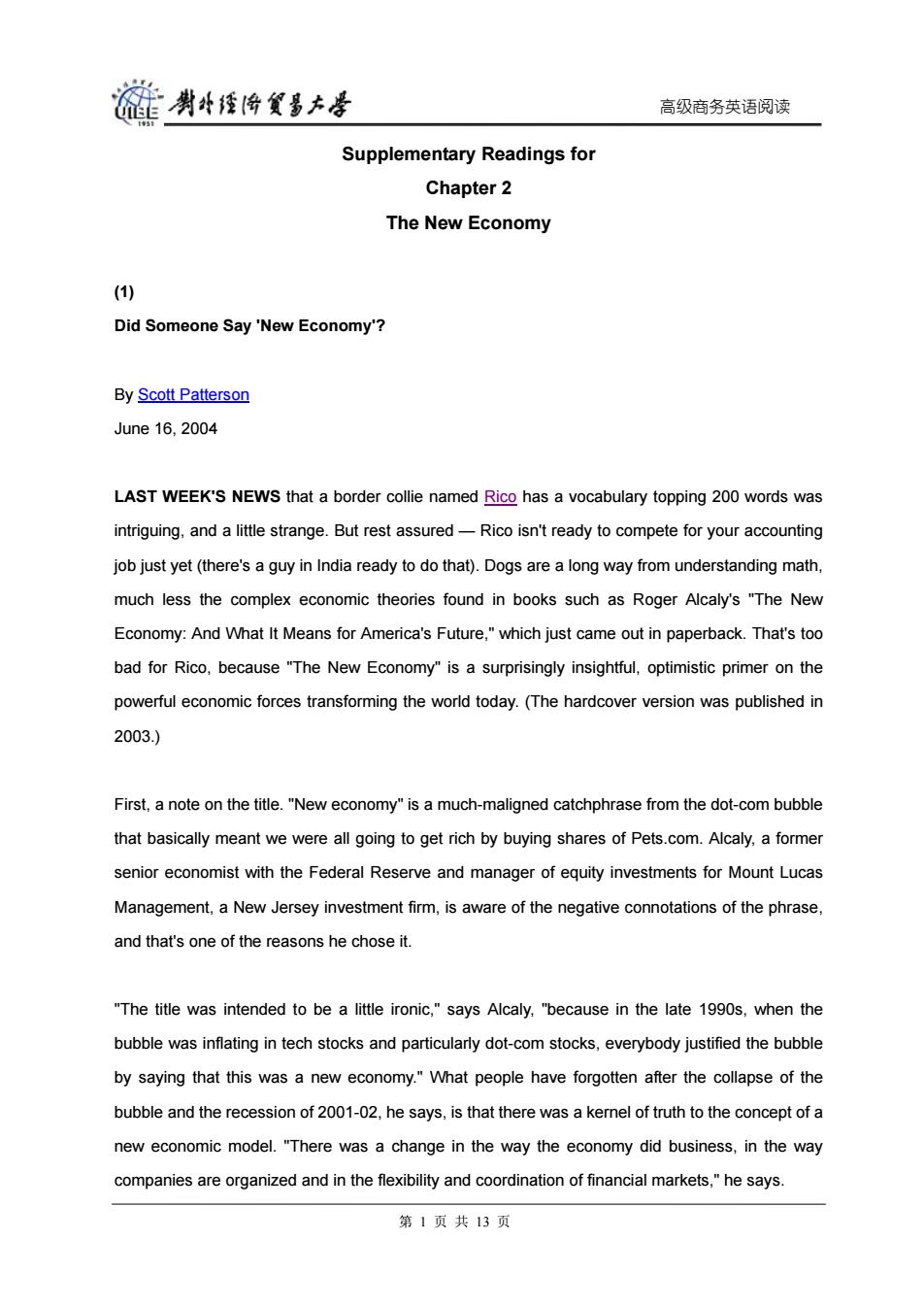
链典4矮降贸多大 高级商务英语阅读 Supplementary Readings for Chapter 2 The New Economy (1) Did Someone Say 'New Economy'? By Scott Patterson June16,2004 LAST WEEK'S NEWS that a border collie named Rico has a vocabulary topping 200 words was intriguing,and a little strange.But rest assured-Rico isn't ready to compete for your accounting job just yet(there's a guy in India ready to do that).Dogs are a long way from understanding math, much less the complex economic theories found in books such as Roger Alcaly's "The New Economy:And What It Means for America's Future,"which just came out in paperback.That's too bad for Rico,because "The New Economy"is a surprisingly insightful,optimistic primer on the powerful economic forces transforming the world today.(The hardcover version was published in 2003.) First,a note on the title."New economy"is a much-maligned catchphrase from the dot-com bubble that basically meant we were all going to get rich by buying shares of Pets.com.Alcaly,a former senior economist with the Federal Reserve and manager of equity investments for Mount Lucas Management,a New Jersey investment firm,is aware of the negative connotations of the phrase, and that's one of the reasons he chose it. "The title was intended to be a little ironic,"says Alcaly,"because in the late 1990s,when the bubble was inflating in tech stocks and particularly dot-com stocks,everybody justified the bubble by saying that this was a new economy."What people have forgotten after the collapse of the bubble and the recession of 2001-02,he says,is that there was a kernel of truth to the concept of a new economic model."There was a change in the way the economy did business,in the way companies are organized and in the flexibility and coordination of financial markets,"he says. 第1页共13页
高级商务英语阅读 Supplementary Readings for Chapter 2 The New Economy (1) Did Someone Say 'New Economy'? By Scott Patterson June 16, 2004 LAST WEEK'S NEWS that a border collie named Rico has a vocabulary topping 200 words was intriguing, and a little strange. But rest assured — Rico isn't ready to compete for your accounting job just yet (there's a guy in India ready to do that). Dogs are a long way from understanding math, much less the complex economic theories found in books such as Roger Alcaly's "The New Economy: And What It Means for America's Future," which just came out in paperback. That's too bad for Rico, because "The New Economy" is a surprisingly insightful, optimistic primer on the powerful economic forces transforming the world today. (The hardcover version was published in 2003.) First, a note on the title. "New economy" is a much-maligned catchphrase from the dot-com bubble that basically meant we were all going to get rich by buying shares of Pets.com. Alcaly, a former senior economist with the Federal Reserve and manager of equity investments for Mount Lucas Management, a New Jersey investment firm, is aware of the negative connotations of the phrase, and that's one of the reasons he chose it. "The title was intended to be a little ironic," says Alcaly, "because in the late 1990s, when the bubble was inflating in tech stocks and particularly dot-com stocks, everybody justified the bubble by saying that this was a new economy." What people have forgotten after the collapse of the bubble and the recession of 2001-02, he says, is that there was a kernel of truth to the concept of a new economic model. "There was a change in the way the economy did business, in the way companies are organized and in the flexibility and coordination of financial markets," he says. 第 1 页 共 13 页
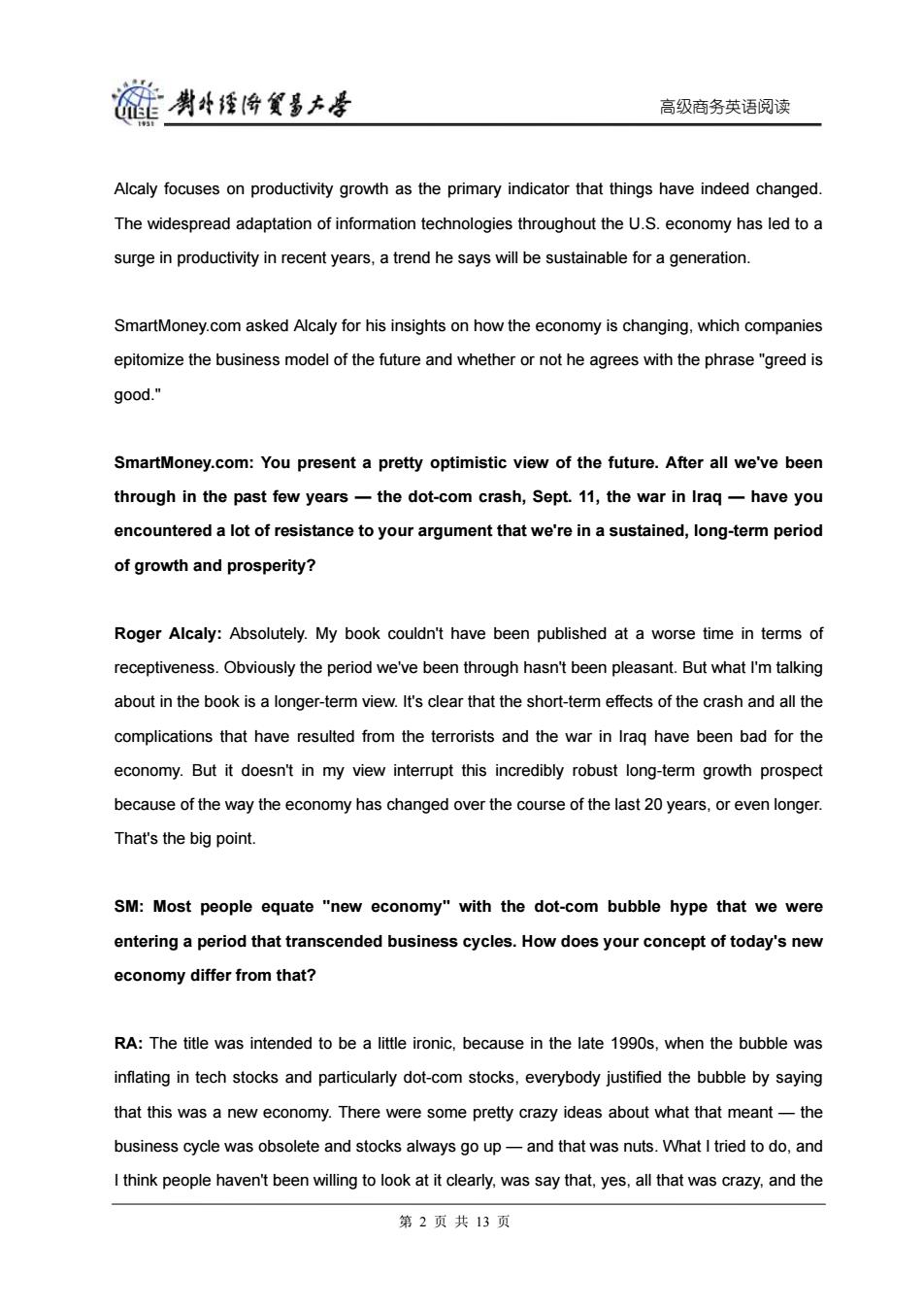
链男牛经海食多大 高级商务英语阅读 Alcaly focuses on productivity growth as the primary indicator that things have indeed changed. The widespread adaptation of information technologies throughout the U.S.economy has led to a surge in productivity in recent years,a trend he says will be sustainable for a generation. SmartMoney.com asked Alcaly for his insights on how the economy is changing,which companies epitomize the business model of the future and whether or not he agrees with the phrase"greed is good." SmartMoney.com:You present a pretty optimistic view of the future.After all we've been through in the past few years-the dot-com crash,Sept.11,the war in Iraq-have you encountered a lot of resistance to your argument that we're in a sustained,long-term period of growth and prosperity? Roger Alcaly:Absolutely.My book couldn't have been published at a worse time in terms of receptiveness.Obviously the period we've been through hasn't been pleasant.But what I'm talking about in the book is a longer-term view.It's clear that the short-term effects of the crash and all the complications that have resulted from the terrorists and the war in Iraq have been bad for the economy.But it doesn't in my view interrupt this incredibly robust long-term growth prospect because of the way the economy has changed over the course of the last 20 years,or even longer. That's the big point. SM:Most people equate "new economy"with the dot-com bubble hype that we were entering a period that transcended business cycles.How does your concept of today's new economy differ from that? RA:The title was intended to be a little ironic,because in the late 1990s,when the bubble was inflating in tech stocks and particularly dot-com stocks,everybody justified the bubble by saying that this was a new economy.There were some pretty crazy ideas about what that meant-the business cycle was obsolete and stocks always go up-and that was nuts.What I tried to do,and I think people haven't been willing to look at it clearly,was say that,yes,all that was crazy,and the 第2页共13页
高级商务英语阅读 Alcaly focuses on productivity growth as the primary indicator that things have indeed changed. The widespread adaptation of information technologies throughout the U.S. economy has led to a surge in productivity in recent years, a trend he says will be sustainable for a generation. SmartMoney.com asked Alcaly for his insights on how the economy is changing, which companies epitomize the business model of the future and whether or not he agrees with the phrase "greed is good." SmartMoney.com: You present a pretty optimistic view of the future. After all we've been through in the past few years — the dot-com crash, Sept. 11, the war in Iraq — have you encountered a lot of resistance to your argument that we're in a sustained, long-term period of growth and prosperity? Roger Alcaly: Absolutely. My book couldn't have been published at a worse time in terms of receptiveness. Obviously the period we've been through hasn't been pleasant. But what I'm talking about in the book is a longer-term view. It's clear that the short-term effects of the crash and all the complications that have resulted from the terrorists and the war in Iraq have been bad for the economy. But it doesn't in my view interrupt this incredibly robust long-term growth prospect because of the way the economy has changed over the course of the last 20 years, or even longer. That's the big point. SM: Most people equate "new economy" with the dot-com bubble hype that we were entering a period that transcended business cycles. How does your concept of today's new economy differ from that? RA: The title was intended to be a little ironic, because in the late 1990s, when the bubble was inflating in tech stocks and particularly dot-com stocks, everybody justified the bubble by saying that this was a new economy. There were some pretty crazy ideas about what that meant — the business cycle was obsolete and stocks always go up — and that was nuts. What I tried to do, and I think people haven't been willing to look at it clearly, was say that, yes, all that was crazy, and the 第 2 页 共 13 页

碰男华经海贸多大号 高级商务英语阅读 bubble was bound to collapse with a lot of collateral damage,but there was something more important going on that will have a huge impact and that will last for a least a generation.There was a change in the way the economy did business.in the way companies are organized and in the flexibility and coordination of financial markets.All of that,combined with the way companies changed their methods of operating,has produced a change in the rate of productivity. SM:You say productivity growth is the best measurement of an economy.Why so? RA:It's the only standard that makes sense,and it's an incredibly powerful one.The important thing [to consider]with productivity growth isn't the short-term movement-it's the long-term trend. What I try to argue is that,whereas productivity had been growing from the early 1970s to the mid-'90s at about 1 1/2%a year,it has subsequently grown twice as rapidly.And I think the rate that is sustainable for the long term-and by that I mean by about a generation-barring external catastrophes that nobody can predict,is about 3%a year.That has incredibly important implications for the economy and for standards of living. SM:What has been the biggest factor in contributing to the growth in productivity that started in the mid-1990s? RA:It appeared in the 1990s,but it was the result of things that had been developing for at least 10 to 20 years before that.It was new technologies in the information and communications industries based on microelectronics and fiber optics.Of equal importance was the way that companies reorganized themselves to take advantage of those new technologies. SM:One of the poster children of the new economy,you say,is Dell Computer(DELL).How does Dell exemplify the new business model? RA:Yes,the prototype of a new economy model is Dell,which really is a middleman between suppliers and customers.A lot of their [computer monitor]screens are made in Mexico.The computer is assembled at other factories.The only time it comes together is when you assemble it at home.I tried to show in the book how this pattern is historic,how the economy periodically goes 第3页共13页
高级商务英语阅读 bubble was bound to collapse with a lot of collateral damage, but there was something more important going on that will have a huge impact and that will last for a least a generation. There was a change in the way the economy did business, in the way companies are organized and in the flexibility and coordination of financial markets. All of that, combined with the way companies changed their methods of operating, has produced a change in the rate of productivity. SM: You say productivity growth is the best measurement of an economy. Why so? RA: It's the only standard that makes sense, and it's an incredibly powerful one. The important thing [to consider] with productivity growth isn't the short-term movement — it's the long-term trend. What I try to argue is that, whereas productivity had been growing from the early 1970s to the mid-'90s at about 1 1/2% a year, it has subsequently grown twice as rapidly. And I think the rate that is sustainable for the long term — and by that I mean by about a generation — barring external catastrophes that nobody can predict, is about 3% a year. That has incredibly important implications for the economy and for standards of living. SM: What has been the biggest factor in contributing to the growth in productivity that started in the mid-1990s? RA: It appeared in the 1990s, but it was the result of things that had been developing for at least 10 to 20 years before that. It was new technologies in the information and communications industries based on microelectronics and fiber optics. Of equal importance was the way that companies reorganized themselves to take advantage of those new technologies. SM: One of the poster children of the new economy, you say, is Dell Computer (DELL). How does Dell exemplify the new business model? RA: Yes, the prototype of a new economy model is Dell, which really is a middleman between suppliers and customers. A lot of their [computer monitor] screens are made in Mexico. The computer is assembled at other factories. The only time it comes together is when you assemble it at home. I tried to show in the book how this pattern is historic, how the economy periodically goes 第 3 页 共 13 页

莲类4将发多大号 高级商务英语阅读 through these sort of great leaps forward.They are always a combination of a new technology that has incredibly broad applicability and the development of a business model that can exploit that new technology.There have been only three or four of these things in the last 200 years.The first was the industrial revolution,which was based on steam power and a shift to factory production. The second was at the turn of the 20th century,which was based on electric power and the development of the mass production model by Henry Ford.And now we have this information-technology revolution were seeing today. SM:You also point to Wal-Mart(WMT)as a model new-economy company. RA:Right,they were one of the pioneers in adapting information technologies to make their business more efficient.They also redesigned their whole distribution system.They built these massive stores,and to service groups of them they had their own distribution centers.They took over the supply function basically,and coordinated with the most advanced information systems. They were pioneers with all the information scanners.Now they're moving on to the radio-frequency tracking system,which I guess is the next big thing.And that's sort of the fundamental point.It's their use of technology-the technology is an enabling device SM:You argue that only during the last few years have we seen the information-technology revolution adding to productivity.To quote one of your chapter headings,"Why did it take so long?" RA:When you look at the gestation period with the development and utilization of electricity,it was very long,just as it was in our case.The transistor was invented in 1947,and we didn't get personal computers until the early 1980s.And we didn't learn how to use them effectively until the mid-'90s.That's when it started showing up in the data.There's a very interesting analogy between the phase in of electric power and the phase in of microelectronics.The first electricity generating plant was in Manhattan,which was set up in 1882.But productivity didn't begin to surge until after World War I.The reasons for that were similar to the reason why it took so long for computers to have a big impact on the economy.It took time for electric power to be widely distributed,and companies had to bring electric power into their factories,which had been built to utilize steam 第4页共13页
高级商务英语阅读 through these sort of great leaps forward. They are always a combination of a new technology that has incredibly broad applicability and the development of a business model that can exploit that new technology. There have been only three or four of these things in the last 200 years. The first was the industrial revolution, which was based on steam power and a shift to factory production. The second was at the turn of the 20th century, which was based on electric power and the development of the mass production model by Henry Ford. And now we have this information-technology revolution were seeing today. SM: You also point to Wal-Mart (WMT) as a model new-economy company. RA: Right, they were one of the pioneers in adapting information technologies to make their business more efficient. They also redesigned their whole distribution system. They built these massive stores, and to service groups of them they had their own distribution centers. They took over the supply function basically, and coordinated with the most advanced information systems. They were pioneers with all the information scanners. Now they're moving on to the radio-frequency tracking system, which I guess is the next big thing. And that's sort of the fundamental point. It's their use of technology — the technology is an enabling device. SM: You argue that only during the last few years have we seen the information-technology revolution adding to productivity. To quote one of your chapter headings, "Why did it take so long?" RA: When you look at the gestation period with the development and utilization of electricity, it was very long, just as it was in our case. The transistor was invented in 1947, and we didn't get personal computers until the early 1980s. And we didn't learn how to use them effectively until the mid-'90s. That's when it started showing up in the data. There's a very interesting analogy between the phase in of electric power and the phase in of microelectronics. The first electricity generating plant was in Manhattan, which was set up in 1882. But productivity didn't begin to surge until after World War I. The reasons for that were similar to the reason why it took so long for computers to have a big impact on the economy. It took time for electric power to be widely distributed, and companies had to bring electric power into their factories, which had been built to utilize steam 第 4 页 共 13 页
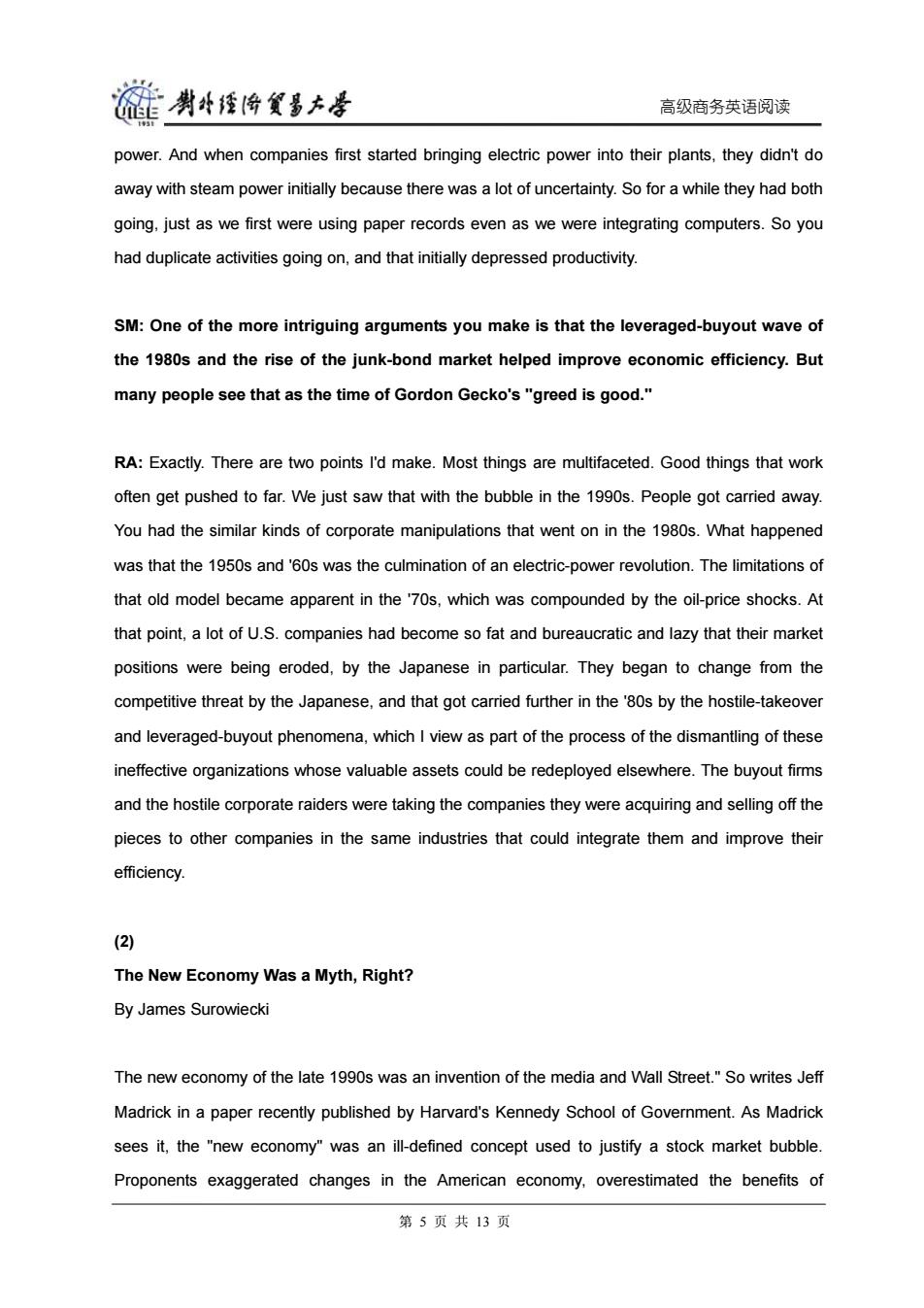
喇牛煙将多大是 高级商务英语阅读 power.And when companies first started bringing electric power into their plants,they didn't do away with steam power initially because there was a lot of uncertainty.So for a while they had both going,just as we first were using paper records even as we were integrating computers.So you had duplicate activities going on,and that initially depressed productivity. SM:One of the more intriguing arguments you make is that the leveraged-buyout wave of the 1980s and the rise of the junk-bond market helped improve economic efficiency.But many people see that as the time of Gordon Gecko's"greed is good." RA:Exactly.There are two points I'd make.Most things are multifaceted.Good things that work often get pushed to far.We just saw that with the bubble in the 1990s.People got carried away. You had the similar kinds of corporate manipulations that went on in the 1980s.What happened was that the 1950s and '60s was the culmination of an electric-power revolution.The limitations of that old model became apparent in the '70s,which was compounded by the oil-price shocks.At that point,a lot of U.S.companies had become so fat and bureaucratic and lazy that their market positions were being eroded,by the Japanese in particular.They began to change from the competitive threat by the Japanese,and that got carried further in the '80s by the hostile-takeover and leveraged-buyout phenomena,which I view as part of the process of the dismantling of these ineffective organizations whose valuable assets could be redeployed elsewhere.The buyout firms and the hostile corporate raiders were taking the companies they were acquiring and selling off the pieces to other companies in the same industries that could integrate them and improve their efficiency. (2) The New Economy Was a Myth,Right? By James Surowiecki The new economy of the late 1990s was an invention of the media and Wall Street."So writes Jeff Madrick in a paper recently published by Harvard's Kennedy School of Government.As Madrick sees it,the "new economy"was an ill-defined concept used to justify a stock market bubble. Proponents exaggerated changes in the American economy,overestimated the benefits of 第5页共13页
高级商务英语阅读 power. And when companies first started bringing electric power into their plants, they didn't do away with steam power initially because there was a lot of uncertainty. So for a while they had both going, just as we first were using paper records even as we were integrating computers. So you had duplicate activities going on, and that initially depressed productivity. SM: One of the more intriguing arguments you make is that the leveraged-buyout wave of the 1980s and the rise of the junk-bond market helped improve economic efficiency. But many people see that as the time of Gordon Gecko's "greed is good." RA: Exactly. There are two points I'd make. Most things are multifaceted. Good things that work often get pushed to far. We just saw that with the bubble in the 1990s. People got carried away. You had the similar kinds of corporate manipulations that went on in the 1980s. What happened was that the 1950s and '60s was the culmination of an electric-power revolution. The limitations of that old model became apparent in the '70s, which was compounded by the oil-price shocks. At that point, a lot of U.S. companies had become so fat and bureaucratic and lazy that their market positions were being eroded, by the Japanese in particular. They began to change from the competitive threat by the Japanese, and that got carried further in the '80s by the hostile-takeover and leveraged-buyout phenomena, which I view as part of the process of the dismantling of these ineffective organizations whose valuable assets could be redeployed elsewhere. The buyout firms and the hostile corporate raiders were taking the companies they were acquiring and selling off the pieces to other companies in the same industries that could integrate them and improve their efficiency. (2) The New Economy Was a Myth, Right? By James Surowiecki The new economy of the late 1990s was an invention of the media and Wall Street." So writes Jeff Madrick in a paper recently published by Harvard's Kennedy School of Government. As Madrick sees it, the "new economy" was an ill-defined concept used to justify a stock market bubble. Proponents exaggerated changes in the American economy, overestimated the benefits of 第 5 页 共 13 页
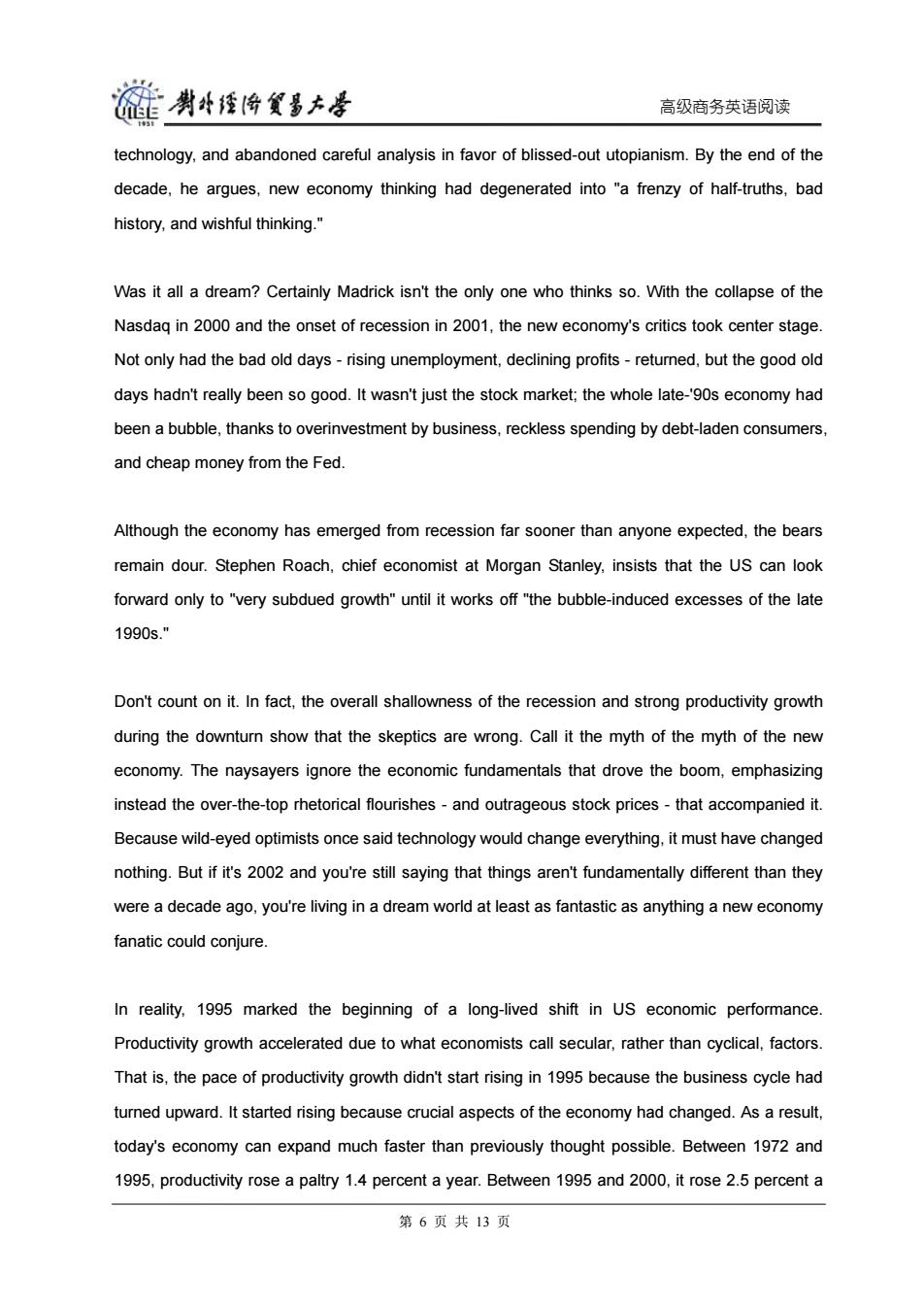
碰剥经悔贸墨大号 高级商务英语阅读 technology,and abandoned careful analysis in favor of blissed-out utopianism.By the end of the decade,he argues,new economy thinking had degenerated into "a frenzy of half-truths,bad history,and wishful thinking." Was it all a dream?Certainly Madrick isn't the only one who thinks so.With the collapse of the Nasdaq in 2000 and the onset of recession in 2001,the new economy's critics took center stage. Not only had the bad old days-rising unemployment,declining profits-returned,but the good old days hadn't really been so good.It wasn't just the stock market;the whole late-'90s economy had been a bubble,thanks to overinvestment by business,reckless spending by debt-laden consumers, and cheap money from the Fed. Although the economy has emerged from recession far sooner than anyone expected,the bears remain dour.Stephen Roach,chief economist at Morgan Stanley,insists that the US can look forward only to "very subdued growth"until it works off "the bubble-induced excesses of the late 1990s." Don't count on it.In fact,the overall shallowness of the recession and strong productivity growth during the downturn show that the skeptics are wrong.Call it the myth of the myth of the new economy.The naysayers ignore the economic fundamentals that drove the boom,emphasizing instead the over-the-top rhetorical flourishes-and outrageous stock prices-that accompanied it. Because wild-eyed optimists once said technology would change everything,it must have changed nothing.But if it's 2002 and you're still saying that things aren't fundamentally different than they were a decade ago,you're living in a dream world at least as fantastic as anything a new economy fanatic could conjure. In reality,1995 marked the beginning of a long-lived shift in US economic performance. Productivity growth accelerated due to what economists call secular,rather than cyclical,factors. That is,the pace of productivity growth didn't start rising in 1995 because the business cycle had turned upward.It started rising because crucial aspects of the economy had changed.As a result. today's economy can expand much faster than previously thought possible.Between 1972 and 1995,productivity rose a paltry 1.4 percent a year.Between 1995 and 2000,it rose 2.5 percent a 第6页共13页
高级商务英语阅读 technology, and abandoned careful analysis in favor of blissed-out utopianism. By the end of the decade, he argues, new economy thinking had degenerated into "a frenzy of half-truths, bad history, and wishful thinking." Was it all a dream? Certainly Madrick isn't the only one who thinks so. With the collapse of the Nasdaq in 2000 and the onset of recession in 2001, the new economy's critics took center stage. Not only had the bad old days - rising unemployment, declining profits - returned, but the good old days hadn't really been so good. It wasn't just the stock market; the whole late-'90s economy had been a bubble, thanks to overinvestment by business, reckless spending by debt-laden consumers, and cheap money from the Fed. Although the economy has emerged from recession far sooner than anyone expected, the bears remain dour. Stephen Roach, chief economist at Morgan Stanley, insists that the US can look forward only to "very subdued growth" until it works off "the bubble-induced excesses of the late 1990s." Don't count on it. In fact, the overall shallowness of the recession and strong productivity growth during the downturn show that the skeptics are wrong. Call it the myth of the myth of the new economy. The naysayers ignore the economic fundamentals that drove the boom, emphasizing instead the over-the-top rhetorical flourishes - and outrageous stock prices - that accompanied it. Because wild-eyed optimists once said technology would change everything, it must have changed nothing. But if it's 2002 and you're still saying that things aren't fundamentally different than they were a decade ago, you're living in a dream world at least as fantastic as anything a new economy fanatic could conjure. In reality, 1995 marked the beginning of a long-lived shift in US economic performance. Productivity growth accelerated due to what economists call secular, rather than cyclical, factors. That is, the pace of productivity growth didn't start rising in 1995 because the business cycle had turned upward. It started rising because crucial aspects of the economy had changed. As a result, today's economy can expand much faster than previously thought possible. Between 1972 and 1995, productivity rose a paltry 1.4 percent a year. Between 1995 and 2000, it rose 2.5 percent a 第 6 页 共 13 页
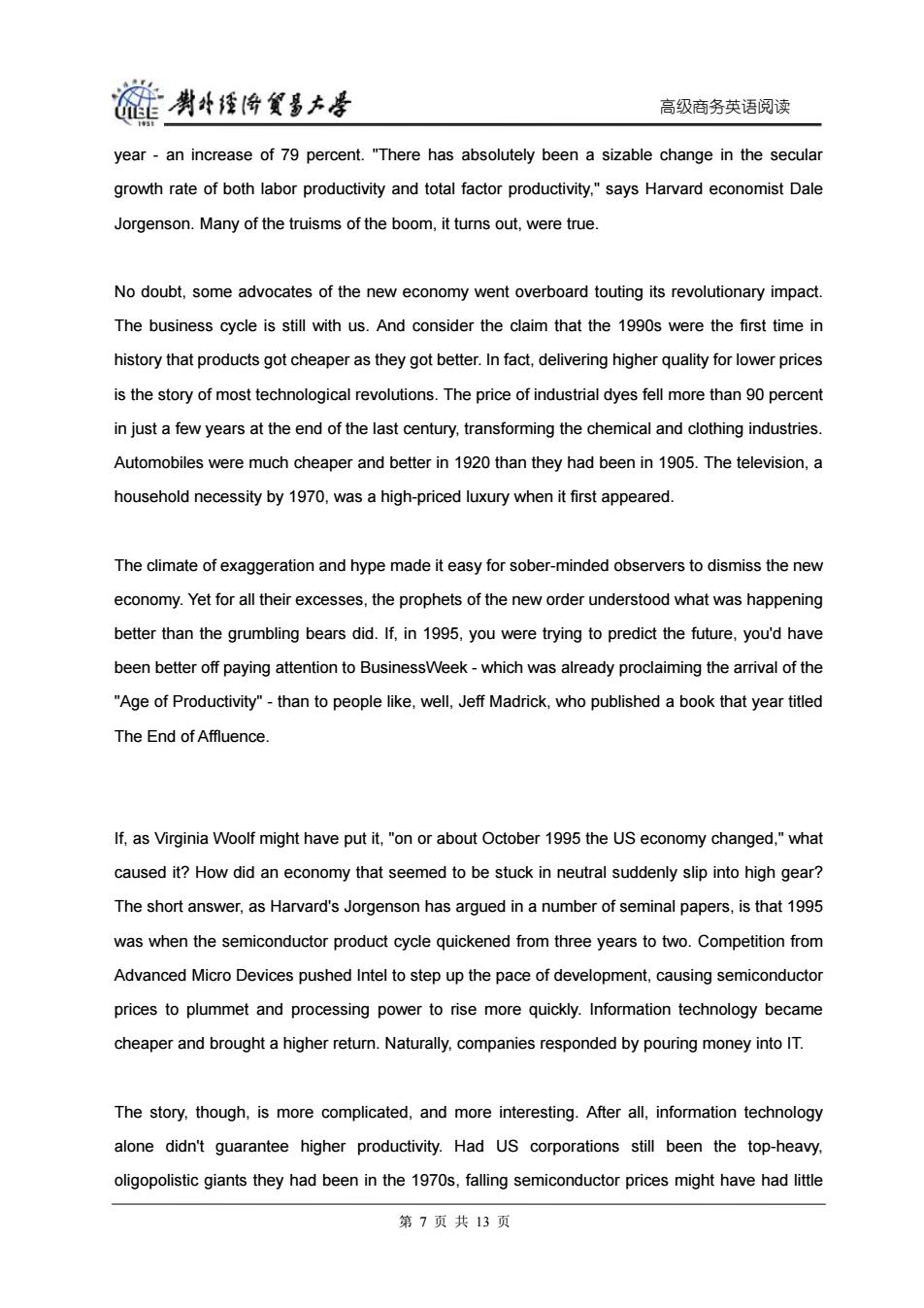
碰男华经海贸多大学 高级商务英语阅读 year-an increase of 79 percent."There has absolutely been a sizable change in the secular growth rate of both labor productivity and total factor productivity,"says Harvard economist Dale Jorgenson.Many of the truisms of the boom,it turns out,were true. No doubt,some advocates of the new economy went overboard touting its revolutionary impact. The business cycle is still with us.And consider the claim that the 1990s were the first time in history that products got cheaper as they got better.In fact,delivering higher quality for lower prices is the story of most technological revolutions.The price of industrial dyes fell more than 90 percent in just a few years at the end of the last century,transforming the chemical and clothing industries. Automobiles were much cheaper and better in 1920 than they had been in 1905.The television,a household necessity by 1970,was a high-priced luxury when it first appeared. The climate of exaggeration and hype made it easy for sober-minded observers to dismiss the new economy.Yet for all their excesses,the prophets of the new order understood what was happening better than the grumbling bears did.If,in 1995,you were trying to predict the future,you'd have been better off paying attention to BusinessWeek-which was already proclaiming the arrival of the "Age of Productivity"-than to people like,well,Jeff Madrick,who published a book that year titled The End of Affluence If,as Virginia Woolf might have put it,"on or about October 1995 the US economy changed,"what caused it?How did an economy that seemed to be stuck in neutral suddenly slip into high gear? The short answer,as Harvard's Jorgenson has argued in a number of seminal papers,is that 1995 was when the semiconductor product cycle quickened from three years to two.Competition from Advanced Micro Devices pushed Intel to step up the pace of development,causing semiconductor prices to plummet and processing power to rise more quickly.Information technology became cheaper and brought a higher return.Naturally,companies responded by pouring money into IT. The story,though,is more complicated,and more interesting.After all,information technology alone didn't guarantee higher productivity.Had US corporations still been the top-heavy, oligopolistic giants they had been in the 1970s,falling semiconductor prices might have had little 第7页共13页
高级商务英语阅读 year - an increase of 79 percent. "There has absolutely been a sizable change in the secular growth rate of both labor productivity and total factor productivity," says Harvard economist Dale Jorgenson. Many of the truisms of the boom, it turns out, were true. No doubt, some advocates of the new economy went overboard touting its revolutionary impact. The business cycle is still with us. And consider the claim that the 1990s were the first time in history that products got cheaper as they got better. In fact, delivering higher quality for lower prices is the story of most technological revolutions. The price of industrial dyes fell more than 90 percent in just a few years at the end of the last century, transforming the chemical and clothing industries. Automobiles were much cheaper and better in 1920 than they had been in 1905. The television, a household necessity by 1970, was a high-priced luxury when it first appeared. The climate of exaggeration and hype made it easy for sober-minded observers to dismiss the new economy. Yet for all their excesses, the prophets of the new order understood what was happening better than the grumbling bears did. If, in 1995, you were trying to predict the future, you'd have been better off paying attention to BusinessWeek - which was already proclaiming the arrival of the "Age of Productivity" - than to people like, well, Jeff Madrick, who published a book that year titled The End of Affluence. If, as Virginia Woolf might have put it, "on or about October 1995 the US economy changed," what caused it? How did an economy that seemed to be stuck in neutral suddenly slip into high gear? The short answer, as Harvard's Jorgenson has argued in a number of seminal papers, is that 1995 was when the semiconductor product cycle quickened from three years to two. Competition from Advanced Micro Devices pushed Intel to step up the pace of development, causing semiconductor prices to plummet and processing power to rise more quickly. Information technology became cheaper and brought a higher return. Naturally, companies responded by pouring money into IT. The story, though, is more complicated, and more interesting. After all, information technology alone didn't guarantee higher productivity. Had US corporations still been the top-heavy, oligopolistic giants they had been in the 1970s, falling semiconductor prices might have had little 第 7 页 共 13 页
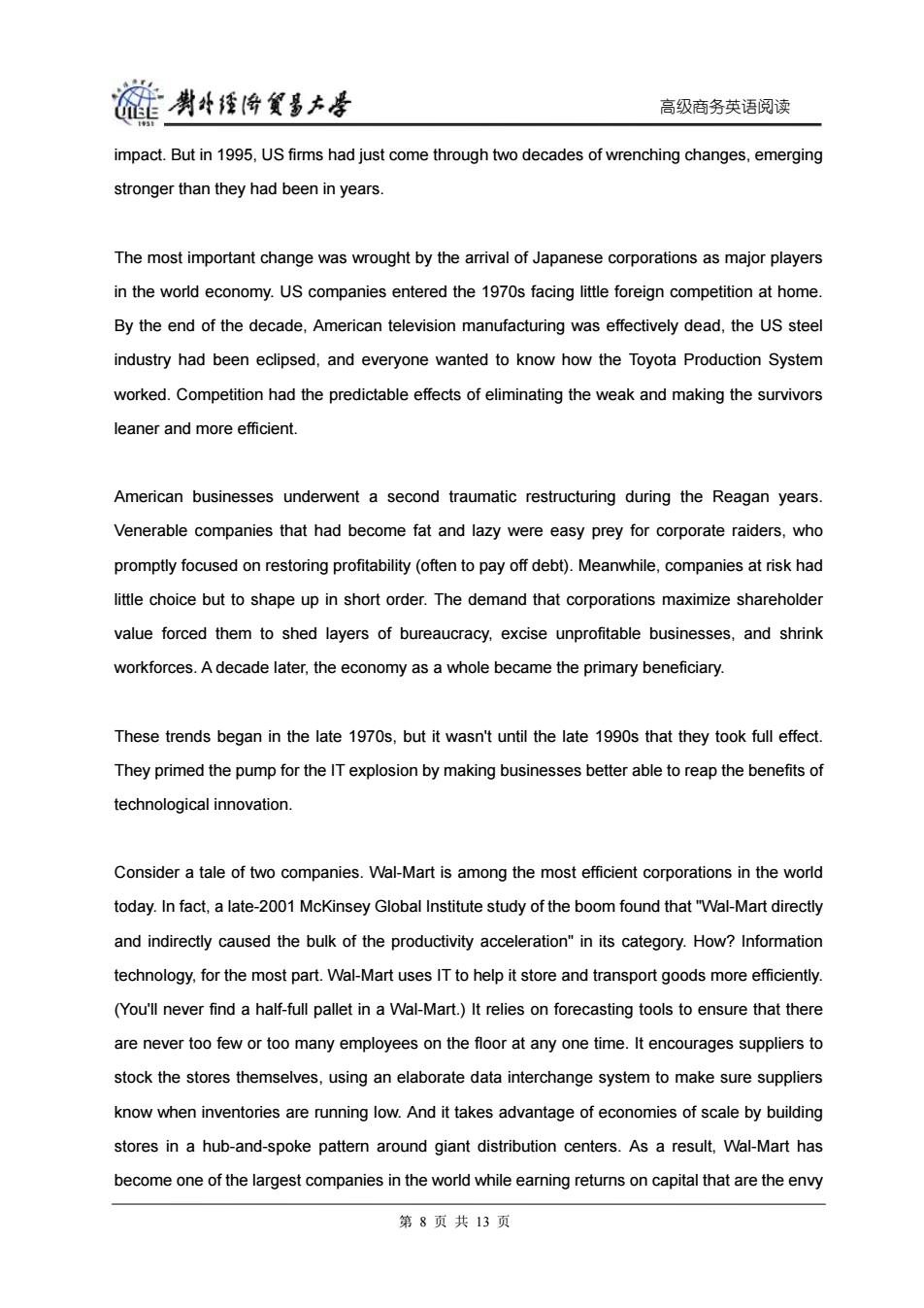
剥牛煙将多大是 高级商务英语阅读 impact.But in 1995,US firms had just come through two decades of wrenching changes,emerging stronger than they had been in years. The most important change was wrought by the arrival of Japanese corporations as major players in the world economy.US companies entered the 1970s facing little foreign competition at home. By the end of the decade,American television manufacturing was effectively dead,the US steel industry had been eclipsed,and everyone wanted to know how the Toyota Production System worked.Competition had the predictable effects of eliminating the weak and making the survivors leaner and more efficient. American businesses underwent a second traumatic restructuring during the Reagan years. Venerable companies that had become fat and lazy were easy prey for corporate raiders,who promptly focused on restoring profitability(often to pay off debt).Meanwhile,companies at risk had little choice but to shape up in short order.The demand that corporations maximize shareholder value forced them to shed layers of bureaucracy,excise unprofitable businesses,and shrink workforces.A decade later,the economy as a whole became the primary beneficiary. These trends began in the late 1970s.but it wasn't until the late 1990s that they took full effect. They primed the pump for the IT explosion by making businesses better able to reap the benefits of technological innovation. Consider a tale of two companies.Wal-Mart is among the most efficient corporations in the world today.In fact,a late-2001 McKinsey Global Institute study of the boom found that"Wal-Mart directly and indirectly caused the bulk of the productivity acceleration"in its category.How?Information technology,for the most part.Wal-Mart uses IT to help it store and transport goods more efficiently. (You'll never find a half-full pallet in a Wal-Mart.)It relies on forecasting tools to ensure that there are never too few or too many employees on the floor at any one time.It encourages suppliers to stock the stores themselves,using an elaborate data interchange system to make sure suppliers know when inventories are running low.And it takes advantage of economies of scale by building stores in a hub-and-spoke pattern around giant distribution centers.As a result,Wal-Mart has become one of the largest companies in the world while earning returns on capital that are the envy 第8页共13页
高级商务英语阅读 impact. But in 1995, US firms had just come through two decades of wrenching changes, emerging stronger than they had been in years. The most important change was wrought by the arrival of Japanese corporations as major players in the world economy. US companies entered the 1970s facing little foreign competition at home. By the end of the decade, American television manufacturing was effectively dead, the US steel industry had been eclipsed, and everyone wanted to know how the Toyota Production System worked. Competition had the predictable effects of eliminating the weak and making the survivors leaner and more efficient. American businesses underwent a second traumatic restructuring during the Reagan years. Venerable companies that had become fat and lazy were easy prey for corporate raiders, who promptly focused on restoring profitability (often to pay off debt). Meanwhile, companies at risk had little choice but to shape up in short order. The demand that corporations maximize shareholder value forced them to shed layers of bureaucracy, excise unprofitable businesses, and shrink workforces. A decade later, the economy as a whole became the primary beneficiary. These trends began in the late 1970s, but it wasn't until the late 1990s that they took full effect. They primed the pump for the IT explosion by making businesses better able to reap the benefits of technological innovation. Consider a tale of two companies. Wal-Mart is among the most efficient corporations in the world today. In fact, a late-2001 McKinsey Global Institute study of the boom found that "Wal-Mart directly and indirectly caused the bulk of the productivity acceleration" in its category. How? Information technology, for the most part. Wal-Mart uses IT to help it store and transport goods more efficiently. (You'll never find a half-full pallet in a Wal-Mart.) It relies on forecasting tools to ensure that there are never too few or too many employees on the floor at any one time. It encourages suppliers to stock the stores themselves, using an elaborate data interchange system to make sure suppliers know when inventories are running low. And it takes advantage of economies of scale by building stores in a hub-and-spoke pattern around giant distribution centers. As a result, Wal-Mart has become one of the largest companies in the world while earning returns on capital that are the envy 第 8 页 共 13 页
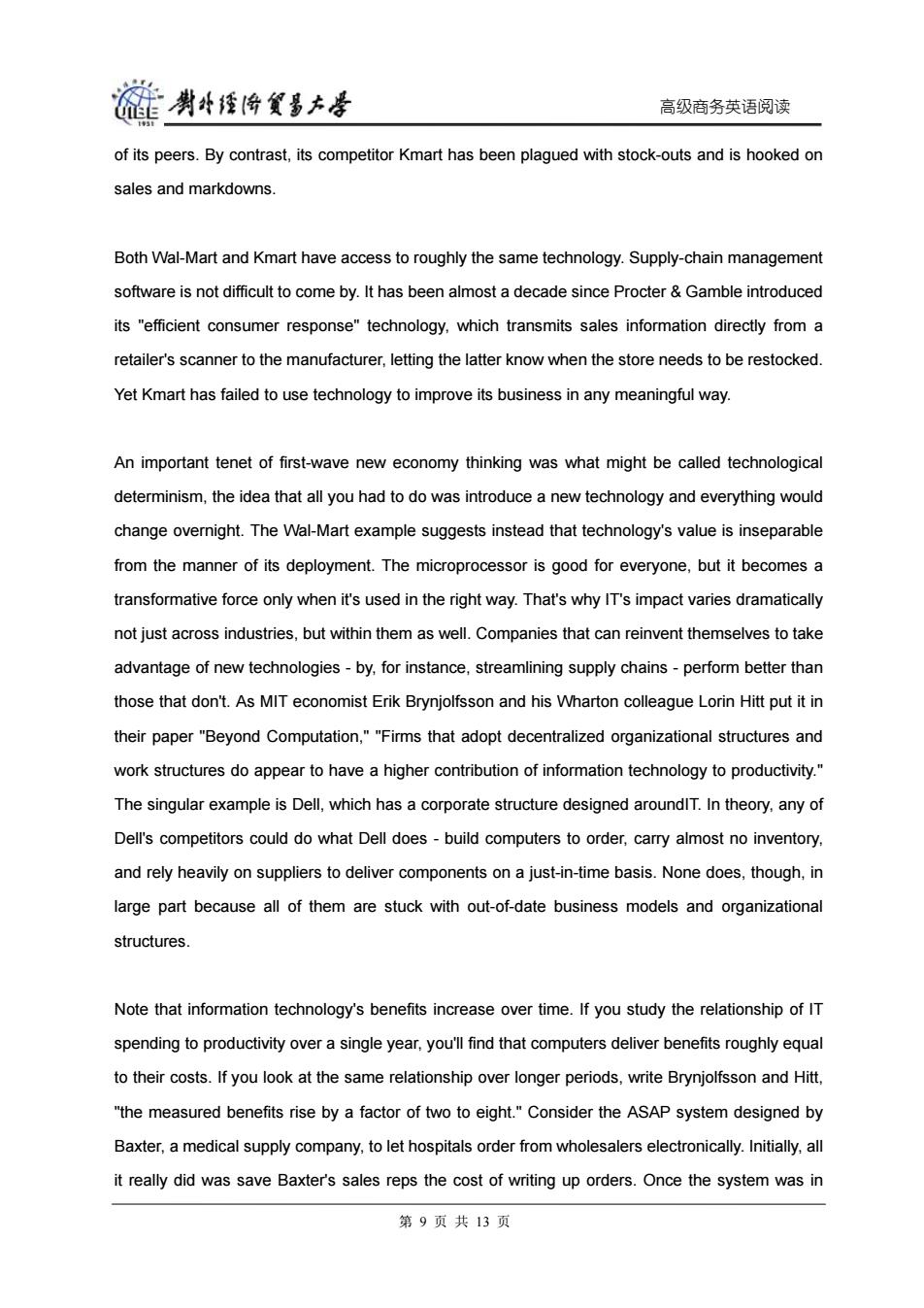
碰男华经海贸多大号 高级商务英语阅读 of its peers.By contrast,its competitor Kmart has been plagued with stock-outs and is hooked on sales and markdowns. Both Wal-Mart and Kmart have access to roughly the same technology.Supply-chain management software is not difficult to come by.It has been almost a decade since Procter Gamble introduced its "efficient consumer response"technology,which transmits sales information directly from a retailer's scanner to the manufacturer,letting the latter know when the store needs to be restocked. Yet Kmart has failed to use technology to improve its business in any meaningful way. An important tenet of first-wave new economy thinking was what might be called technological determinism,the idea that all you had to do was introduce a new technology and everything would change overnight.The Wal-Mart example suggests instead that technology's value is inseparable from the manner of its deployment.The microprocessor is good for everyone,but it becomes a transformative force only when it's used in the right way.That's why IT's impact varies dramatically not just across industries,but within them as well.Companies that can reinvent themselves to take advantage of new technologies-by,for instance,streamlining supply chains-perform better than those that don't.As MIT economist Erik Brynjolfsson and his Wharton colleague Lorin Hitt put it in their paper "Beyond Computation,""Firms that adopt decentralized organizational structures and work structures do appear to have a higher contribution of information technology to productivity. The singular example is Dell,which has a corporate structure designed aroundIT.In theory,any of Dell's competitors could do what Dell does-build computers to order,carry almost no inventory, and rely heavily on suppliers to deliver components on a just-in-time basis.None does,though,in large part because all of them are stuck with out-of-date business models and organizational structures. Note that information technology's benefits increase over time.If you study the relationship of IT spending to productivity over a single year,you'll find that computers deliver benefits roughly equal to their costs.If you look at the same relationship over longer periods,write Brynjolfsson and Hitt, "the measured benefits rise by a factor of two to eight."Consider the ASAP system designed by Baxter,a medical supply company,to let hospitals order from wholesalers electronically.Initially,all it really did was save Baxter's sales reps the cost of writing up orders.Once the system was in 第9页共13页
高级商务英语阅读 of its peers. By contrast, its competitor Kmart has been plagued with stock-outs and is hooked on sales and markdowns. Both Wal-Mart and Kmart have access to roughly the same technology. Supply-chain management software is not difficult to come by. It has been almost a decade since Procter & Gamble introduced its "efficient consumer response" technology, which transmits sales information directly from a retailer's scanner to the manufacturer, letting the latter know when the store needs to be restocked. Yet Kmart has failed to use technology to improve its business in any meaningful way. An important tenet of first-wave new economy thinking was what might be called technological determinism, the idea that all you had to do was introduce a new technology and everything would change overnight. The Wal-Mart example suggests instead that technology's value is inseparable from the manner of its deployment. The microprocessor is good for everyone, but it becomes a transformative force only when it's used in the right way. That's why IT's impact varies dramatically not just across industries, but within them as well. Companies that can reinvent themselves to take advantage of new technologies - by, for instance, streamlining supply chains - perform better than those that don't. As MIT economist Erik Brynjolfsson and his Wharton colleague Lorin Hitt put it in their paper "Beyond Computation," "Firms that adopt decentralized organizational structures and work structures do appear to have a higher contribution of information technology to productivity." The singular example is Dell, which has a corporate structure designed aroundIT. In theory, any of Dell's competitors could do what Dell does - build computers to order, carry almost no inventory, and rely heavily on suppliers to deliver components on a just-in-time basis. None does, though, in large part because all of them are stuck with out-of-date business models and organizational structures. Note that information technology's benefits increase over time. If you study the relationship of IT spending to productivity over a single year, you'll find that computers deliver benefits roughly equal to their costs. If you look at the same relationship over longer periods, write Brynjolfsson and Hitt, "the measured benefits rise by a factor of two to eight." Consider the ASAP system designed by Baxter, a medical supply company, to let hospitals order from wholesalers electronically. Initially, all it really did was save Baxter's sales reps the cost of writing up orders. Once the system was in 第 9 页 共 13 页
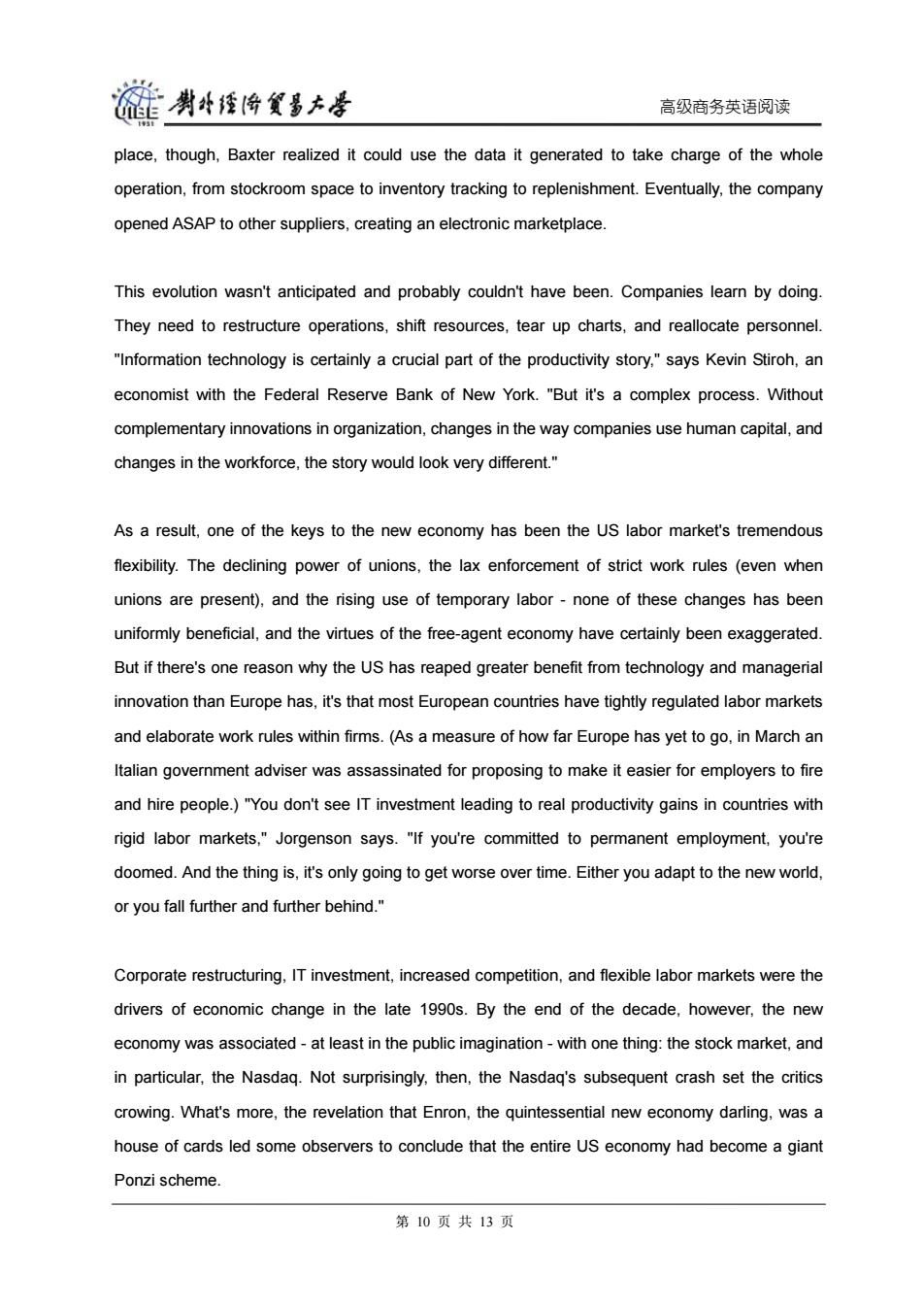
剥牛煙将多大是 高级商务英语阅读 place,though,Baxter realized it could use the data it generated to take charge of the whole operation,from stockroom space to inventory tracking to replenishment.Eventually,the company opened ASAP to other suppliers,creating an electronic marketplace. This evolution wasn't anticipated and probably couldn't have been.Companies learn by doing. They need to restructure operations,shift resources,tear up charts,and reallocate personnel. "Information technology is certainly a crucial part of the productivity story,"says Kevin Stiroh,an economist with the Federal Reserve Bank of New York."But it's a complex process.Without complementary innovations in organization,changes in the way companies use human capital,and changes in the workforce,the story would look very different." As a result,one of the keys to the new economy has been the US labor market's tremendous flexibility.The declining power of unions,the lax enforcement of strict work rules (even when unions are present),and the rising use of temporary labor-none of these changes has been uniformly beneficial,and the virtues of the free-agent economy have certainly been exaggerated. But if there's one reason why the US has reaped greater benefit from technology and managerial innovation than Europe has,it's that most European countries have tightly regulated labor markets and elaborate work rules within firms.(As a measure of how far Europe has yet to go,in March an Italian government adviser was assassinated for proposing to make it easier for employers to fire and hire people.)"You don't see IT investment leading to real productivity gains in countries with rigid labor markets,"Jorgenson says."If you're committed to permanent employment,you're doomed.And the thing is,it's only going to get worse over time.Either you adapt to the new world, or you fall further and further behind." Corporate restructuring,IT investment,increased competition,and flexible labor markets were the drivers of economic change in the late 1990s.By the end of the decade,however,the new economy was associated-at least in the public imagination-with one thing:the stock market,and in particular,the Nasdaq.Not surprisingly,then,the Nasdaq's subsequent crash set the critics crowing.What's more,the revelation that Enron,the quintessential new economy darling,was a house of cards led some observers to conclude that the entire US economy had become a giant Ponzi scheme. 第10页共13页
高级商务英语阅读 place, though, Baxter realized it could use the data it generated to take charge of the whole operation, from stockroom space to inventory tracking to replenishment. Eventually, the company opened ASAP to other suppliers, creating an electronic marketplace. This evolution wasn't anticipated and probably couldn't have been. Companies learn by doing. They need to restructure operations, shift resources, tear up charts, and reallocate personnel. "Information technology is certainly a crucial part of the productivity story," says Kevin Stiroh, an economist with the Federal Reserve Bank of New York. "But it's a complex process. Without complementary innovations in organization, changes in the way companies use human capital, and changes in the workforce, the story would look very different." As a result, one of the keys to the new economy has been the US labor market's tremendous flexibility. The declining power of unions, the lax enforcement of strict work rules (even when unions are present), and the rising use of temporary labor - none of these changes has been uniformly beneficial, and the virtues of the free-agent economy have certainly been exaggerated. But if there's one reason why the US has reaped greater benefit from technology and managerial innovation than Europe has, it's that most European countries have tightly regulated labor markets and elaborate work rules within firms. (As a measure of how far Europe has yet to go, in March an Italian government adviser was assassinated for proposing to make it easier for employers to fire and hire people.) "You don't see IT investment leading to real productivity gains in countries with rigid labor markets," Jorgenson says. "If you're committed to permanent employment, you're doomed. And the thing is, it's only going to get worse over time. Either you adapt to the new world, or you fall further and further behind." Corporate restructuring, IT investment, increased competition, and flexible labor markets were the drivers of economic change in the late 1990s. By the end of the decade, however, the new economy was associated - at least in the public imagination - with one thing: the stock market, and in particular, the Nasdaq. Not surprisingly, then, the Nasdaq's subsequent crash set the critics crowing. What's more, the revelation that Enron, the quintessential new economy darling, was a house of cards led some observers to conclude that the entire US economy had become a giant Ponzi scheme. 第 10 页 共 13 页